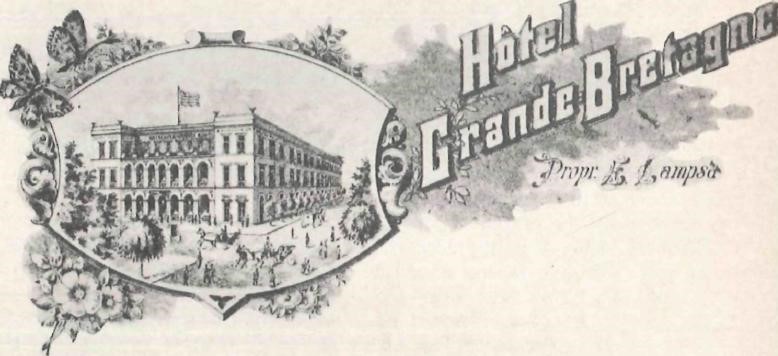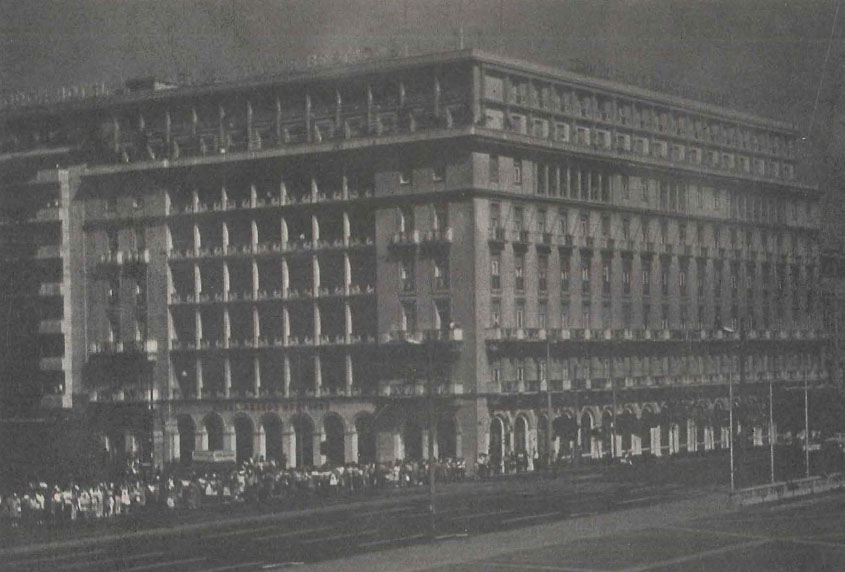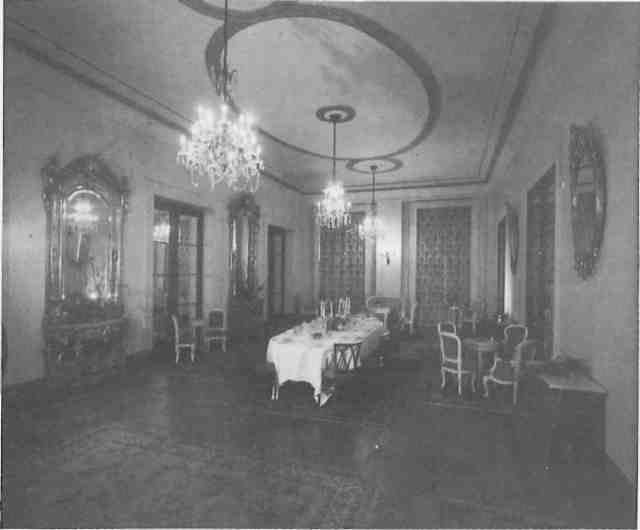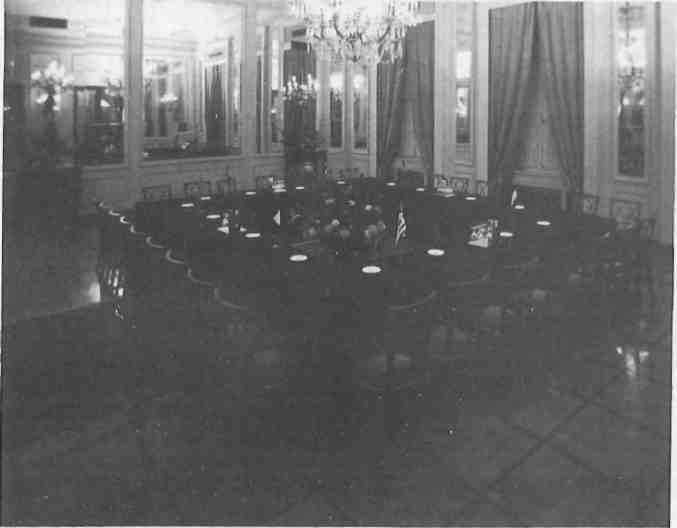Most great cities have one. London has Claridges, Singapore has Raffles, Paris has The Ritz, Bombay has the Taj Mahal: that 5-star hotel that is a little more than just another de luxe conference centre and international businessmen’s ‘home away from home’, and can actually lay claim to a place in the history books. Athens has the Grande Bretagne.

For almost 150 years, from her vantage point at the bustling junction of Panepistimiou, Vasilissis Sofias and Amalias avenues , and rubbing shoulders with the parliament building (erstwhile the royal palace), the great-grandmother of Greek hotels has borne witness to the most turbulent events in modern Greek history and lived to tell the tale.

The Grande Bretagne started life in 1842 as a luxurious private mansion, built by Antonis Dimitriou, a wealthy Greek expatriate from Trieste, and designed by the Danish architect Theophile Hansen.
Athens, a small town with a population of 20,000, had been the Greek capital for a mere eight years, and the present-day Syntagma Square area was a rural idyll of fields and vineyards. Ten years later, the mansion changed hands for the first time, and its new owners, the Klados family, rented it out to the French Archaeological School, who used it as their base for over 20 years.
Meanwhile, in 1863, the same year that the Danish King George I acceded to the throne, an 11-year-old boy, Stathis Lampsas, arrived in Athens with his family on foot from Odessa. In a remarkable leap from rags to riches, this young boy was to be the key figure in the Grande Bretagne story.
While in the Royal kitchens, Stathis’ talents as a cook were recognized and he was dispatched by the King to Paris to study the art of haute cuisine, with a view to his becoming a master chef at the palace. He returned to Athens a wealthy and accomplished chef, with his new French bride, Palmyr Palfroy.
Shortly after his return, he forged a partnership with Savas Kendros, owner of one of Athens’ few hotels, the Megali Vretannia, which stood at the corner of Karageorgis Servias and Stadiou streets, and the two decided to buy the elegant mansion up the road which housed the French Archaeological School, feeling confident that they could provide a better class of accommodation for the increasing number of distinguished visitors to the capital. Perhaps to invoke images of the traditions of the great British ‘Grand Tour’, the name of Kendros’ old hotel was used, but in its Gallicized form, no doubt at the suggestion of the highly influential Palfroy.
When the Grande Bretagne Hotel first opened its portals in 1874, one guest traveller was moved to remark “The luxury that prevails is worthy of special mention. Such hotels are adornments to a city. Who could imagine that Athens, which is going through the first stages of its life after so many years of servitude, would have hotels capable of receiving kings and queens?”
The new hotel’s interior decor reflected the height of French ‘Belle Epoque’ taste. Under the supervision of Palfroy, the very best furniture, crockery, chandeliers and carpets were imported. Old masters and huge Gobelin tapestries hung in the entrance hall, while Rosenthal porcelain, Parisian vermeil cutlery and hand-made Murano glassware adorned the dining-room.

On Kendros’ death in 1888, Lampsas bought out his partner’s share in the business, and, in the same year, the hotel’s luxury status was further enhanced when Greece’s first electric generators were installed. The ‘GB’ was the natural choice of accommodation for Baron de Coubertin and the other dignitaries at the 1896 inauguration of the modern Olympics.
For all the sumptuousness, however, the hotel’s 80 bedrooms shared only two bathrooms between them, and a serious water shortage in Athens meant that staff had to carry cans of water into the building, filled up from water-carriers, whose wagons passed in the street.
Another self-made man of humble background in the Lampsas mould, a young lawyer-journalist by the name of Theodore Petrakopoulos, was to be the next leading character in the ‘GB’ story. An enlightening article that he had written concerning the Italian tourist trade came to Lampsas’ attention, and he was determined to meet the young man. So favorably impressed was he with Petrakopoulos’ credentials that he offered him the hand of his adopted daughter and only child, Margarita, in marriage, and duly appointed him manager of the hotel.
A fervent Venizelist, Petrakopoulos took an active role in politics, and undertook several important diplomatic missions for the great statesman. It was under Petrakopoulos that the hotel became a central meeting place for the influential. Guests included kings, princes and presidents, and the salons of the Grande Bretagne began to buzz with political discussion and the intricacies of important business and shipping deals.
During World War I and the conflict between King Constantine and Venizelos, many a secret plot was said to have been hatched there. One of the more colorful guests during this period was a wealthy American lady who stormed out of her suite one day, complaining that her valuable pearl necklace had vanished. One unfortunate valet was arrested, a huge compensation was paid out, and the whole episode was kept quiet until, many years later, while installing a new wash basin in the room, plumbers discovered the missing necklace lodged in a pipe.
In 1918, shortly before Lampsas’ death, Petrakopoulos became the single outright owner of the hotel. A few years later, the hotel acquired an annex: the building in Vasilissis Sofias which now houses the Italian Embassy became the ‘Petit Palais’, welcoming, like its sister hotel, a distinguished international clientele and the cream of Athenian society. As well as most official guests of state, the list of rich and famous guests at this time included Douglas Fairbanks and his wife, Mary Pickford, who were regular visitors. Legend has it that, despite the comfortable size of the elegant rooms, Miss Pickford had to hire another room in which to keep her shoes,
In 1928, a new wing was added to the ‘GB’ along Panepistimiou and Voukourestiou, and 11 years later it saw another landmark in its history: it became the first hotel in Europe to install air conditioning.
During World War II and the ensuing Greek civil war, the Grande Bretagne became the focus of military and political activity for more than ten years. In 1940, the Greek authorities requisitioned the building as general staff headquarters. Guests were given an hour to evacuate their rooms, which they all did willingly except for the German military attache, who insisted he was staying put. Rudolf Schmidt, the Swiss manager, finally persuaded him to leave, but six months later he was forced to admit hundreds of other German officers when the hotel was turned over to become the ‘Hauptquartiers der Wehrmacht’.
The story goes that when the Nazis mentioned the incongruity of the hotel’s name as their army headquarters, the management was quick to point out that one of Hitler’s favorite hotels in Britain was called the Bristol. The matter was dropped! Two floors of the hotel were later allocated to the Germans’ Axis partner, Italy. Herman Goering was a regular guest at the Grande Bretagne, while Himmler stayed there while he was inspecting the Gestapo, and both Rommel and Hitler paid fleeting visits.

With the departure of the Germans in September 1944, the liberating British Expeditionary Force, under General Scobie, in turn chose the ‘GB’ as its headquarters. But the strife outside its now sadly-bedraggled salons and suites continued, the lift was out of order, and electricity and water were both intermittent. A visiting English writer likened the hotel to a “stranded ship, a great helpless liner” amidst the mayhem. It became a fortified home to 1,500 people, a strange hotchpotch of ministers, politicians, industrialists and their families, refugees and troops. While British paratroops manned machine guns in the lobby, the big ballroom served as a general mess, and there were ten people to a bedroom. Everyone helped out with the general housekeeping and cooking, including Mrs George Papandreou, the premier’s wife.
Meanwhile, elsewhere in the hotel, intense top-level discussions were under way between the Papandreou government and the British delegation, led by Harold MacMillan. On Christmas day 1944, both the ‘GB’ and Winston Churchill narrowly escaped a gun-powder plot. Hours before the British Prime Minister’s scheduled meeting with Archbishop Damaskinos at the hotel, plumbers inspecting sewers under Syntagma Square came across a time-bomb connected to one ton of dynamite. The bomb was duly defused, the meeting was, not surprisingly, relocated, and Churchill left Athens without visiting the Grande Bretagne, an omission which he did, however, make up for 20 years later as the guest of Aristotle Onassis.
General Scobie, too, had a lucky escape when working in his office one day on the sixth floor: a mortar shell fell only two feet away from where he was sitting. Miraculously, though, in the end the ‘GB’ had survived the ravages of war relatively unscathed, sustaining only some superficial damage from rifle shots. But- it did take over a million dollars to restore the interior, after ten years of military occupation, to its former glory.
The most famous incident enhancing the Grande Bretagne’s reputation as a centre of intrigue and espionage occurred in 1949. George Polk, an American CBS reporter,one night, perhaps rather foolhardily, chose the bar of the ‘GB’ (the presentday ‘Mirror Room’) in which to announce his intention to travel up to northern Greece and uncover the secret mountain headquarters of the Communist guerrillas. The next day, Polk flew up to Thessaloniki. His trussed body was discovered a few days later floating in the harbor. The murder remained controversial and two major books were published on the subject last year.

Opinion in Athens, however, held that it had been the work of right-wing extremists who had plotted the whole affair in the ‘GB’ bar, intending to implicate the Communists. Thereafter, the bar became known as the ‘Snakepit’.
In 1956, the hotel underwent its second major renovation and assumed the basic form we see today: an extra four floors were added and the entrance was refaced in marble. Capacity was increased to 670 guests, accommodated in 450 rooms and luxury suites ranging from ‘junior’ to ‘presidential’, But after so many years of active participation, how could she remain a passive bystander to Greece’s ever-volatile political life?
During the Cyprus crisis of the late 1950s, in view of widespread anti-British sentiment, the management was forced to drop the hotel’s somewhat provocative name temporarily, and the name of Theodore Petrakopoulos’ old annex, ‘Petit Palais’, was adopted for a time. But when Petrakopoulos died at the age of 85 in 1963, Greek politicians forgot their differences for once, and the Prime Minister walked alongside the leader of the opposition behind the funeral cortege.
The tourist boom of the 1960s and 1970s brought with it new competition for the Grande Bretagne, as new de luxe hotels sprang up in the capital. Modernizations were carried out accordingly, not always to the approval of regular guests.
In his book Roumeli, Patrick Leigh Fermour bemoans the transformation of the old hall into a “vast and aseptic” area with the “impersonality of an airport lounge”. However, the ‘GB’ managed to rise above the slump of the 1980s, when several other top-class central hotels, such as the King George and the King’s Palace, were forced to close.
The Grande Bretagne was once again an eyewitness of history when the tanks roared into Syntagma during the 1967 coup. When Constantine Karamanlis returned from exile in 1974, he stayed at the ‘GB’ for four months, and it was from a second floor balcony of the hotel that Archbishop Makarios addressed the Greek people on his way back to Cyprus after his near-assassination and the Turkish occupation of the northern part of the island.
Several years ago, a corner of the building which had been leased to a bank was reclaimed, and the ‘GB’ corner was created. Under the charge of Lambros Kapiris, a former personal waiter to the Greek King, it is now a prime meeting place for the Athens elite; politicians, business people, actors and actresses.
The guest list for the past two years makes impressive reading: Willy Brandt, Bruce Springsteen, Christian Bernard, Joan Collins, Prince Rainier of Monaco, Elizabeth Taylor, Peter Ustinov and Yehudi Menuhin, to take a very random sample. The hotel staff is full of stories of the quirks of the great: during his stay, Yassar Arafat was escorted wherever he went by bodyguards shielding him with a bullet-proof curtain; confronted with a choice of the best wines in the world, Aristotle Onassis preferred a half-bottle of Demestica red with his meal; Indira Gandhi fell so much in love with the reproduction of ancient Greek lichnoi in her presidential suite that the manager promptly gave her a pair as a gift. The hotel has also starred in several movies, including the British TV series The Fortunes of War.

Today, the ‘GB’ still enjoys the position of being one of the most prestigious hotels in Athens, as the only Greek entry in the American directory Leading Hotels of the World. While maintaining an ‘old world’ atmosphere, it offers ultra-modern comforts in all rooms: mini-bar, color TV with satellite and video facilities and directdial telephones in every bathroom. Like one of the great bridges of the world, it is under a program of constant maintenance and renovation, and a staff of 400 ensures that the great machine is kept well-oiled and running smoothly. Plans for the future include a large indoor swimming pool, sauna and health spa.
The Dimitriou mansion has certainly come a long way since the iniative of a young chef 120 years ago.







